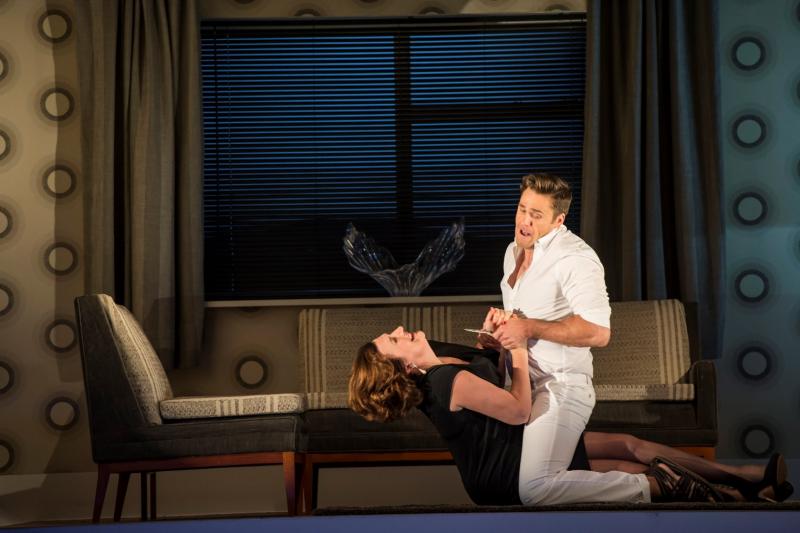


Jean-Philippe Rameau wrote Hippolyte et Aricie in 1733 at the age of 50. It was his first opera and his greatest. In its five acts, its visits to the woods of Diana, the groves of Venus, the fires of Pluto and the domestic meltdown in the house of Phaedra, is some of the most assured, inventive and stylish music ever written for the stage. As operatic debuts go, it is a miracle.
That William Christie, the pre-eminent French Baroque specialist of our age, would be capable of summoning up some of the premiere’s dazzle was not surprising. But that Jonathan Kent would be able to match that sense of wonder that greeted 18th-century Parisians with a staging that both channelled a multi-media Baroque spirit but also got to the work’s intimate core was a revelation.
We began, of course, in a fridge-freezer. "Huh?" some cried. Opera’s seen many a fridge-freezer in recent years, from the big walk-in meat storers (Turandot, ENO) to the cheap Dixon’s knock-offs (King Arthur, ENO). This one was exaggeratedly large – large enough to fit the choir and two goddesses – and French. So, who might make this trope of modern consumerism their home? Diana, of course, queen of the hunt, patron saint of the frigid.
Few nights at the opera will be as rewarding as this one
It was neat. But it was by no means the most neat scene we’d see. Next up came Diana’s Maurizio Catelan-inspired abattoir, four real deer strung up dead, blood pouring from their mouths. Even more ingenious was Pluto’s domain in Act Three where we explored the flea-ridden, cobwebbed back of the fridge. For the domestic unravelling in Act Four, the curtain lifted on a cross-section of the ruling family home, the fateful drama unfolding like a frieze across the modish bedrooms and living room.
True to its time, purity is absent. Generosity and spectacle are the order of the day. We get Noughties designs here, 18th-century costume there (designer: Paul Brown). The plot allows it. The fecund music – hungrily zig-zagging across vast, previously uncharted textural and harmonic terrain – demands it. For those expecting Racine’s Phaedra, it will disappoint, maybe even horrify. Rameau’s librettist Abbé Pellegrin subsumes all the sober interior turmoil of Phaedra into a lavish grand opera that takes in several prolonged (and, it has to be said, dramatically static) visits to the Gods. Nonetheless there is time for much intimate activity too.
Kent is not averse to Racine-ifying proceedings when necessary. Two of the most heart-stopping moments in this production – moments that belie the idea that French Baroque opera is all surface and no soul – are moments of great classical restraint. The first is the breakdown of Phaedra in her bedroom in Act Three, while the object of her desire, her step-son Hippolyte, does his teenage thing next door. The second is at the end of Act Four. The curtain falls to leave Phaedra alone, the lights narrow to a spot and, in silence, she descends to meet her fate, eying us accusingly. The only misstep in the production was in the pat choreography from Ashley Page, who rather than taking on the ravishing dance music, sends them up in moments of half-arsed campness.
That both the best moments involved Sarah Connolly [3] was no coincidence. Her ability to inhabit these complex, tortured women – remember her Medea this year – is peerless. And so it was inevitable perhaps that her rendition of “Cruelle mère des amours” would be the hypnotic heart of the evening. But this was a cast full of talent. Ed Lyon (Hippolyte), a Christie favourite and a bit of a French Baroque star across the channel, finally got the chance to show off his skills here. He can be a little pushed and get a little nasally up high but he’s a terrific actor and a wonderful stylist. Whether as a red-faced and behorned Pluto or sweaty and bare-chested Neptune, François Lis was a decent bad guy, though slightly upstaged by Loic Felix as the yelping Pluto sidekick, Tisiphone.
The guys were good. But the girls were great. Hatching from an egg in the fridge, Ana Quintans’ Cupid, a punkish chick in this production, was, in her sparkling tone, a model siren of desire. The same attractiveness of sound could be found in the delicious though small contributions from Emmanuelle de Negri (Huntress and Nightingale) and Julie Pasturaud (Oenone). The star act though was Christiane Karg as Aricie.
It’s a role created by Pellegrin, to move the focus of the story away from the damaged goods that Phaedra represents to something more wholesome and youthtful. For our times, this can all seem a bit drippy. But not in Karg’s hands. This manipulated innocent becomes something quite mesmerising. Karg's ability to control and colour her vocal line, making every ornament, every delicious port de voix and coulez, tell within the context of the words, meant she manipulated us as much as they her.
Of course the cue for this exquisite colourism came ultimately from Christie and the Orchestra of the Age of Enlightenment [4], who teased us in a ravishing way, especially when the flutes took control of the musical eddies. It was a reminder that, for all the activity on stage, the night belonged to Rameau. The variety, richness and experimentation of his writing – the solos, duets, trios, choruses, a cappella and accompanied, all exquisitely orchestrated – allows his operas to be fleet of foot in a way few others would be before or since. As fellow composer Andre Campra remarked at the premiere, "There is enough music in this opera to make 10 of them.” Few nights at the opera will be as rewarding as this one.
Links
[1] https://theartsdesk.com/users/igortoronyilalic
[2] https://www.addtoany.com/share_save
[3] http://www.theartsdesk.com/opera/theartsdesk-qa-mezzo-soprano-sarah-connolly
[4] http://www.theartsdesk.com/topics/orchestra-age-enlightenment
[5] https://theartsdesk.com/node/17210/view
[6] https://theartsdesk.com/node/65496/view
[7] https://theartsdesk.com/node/588/view
[8] https://theartsdesk.com/node/386/view
[9] https://theartsdesk.com/node/70172/view
[10] https://theartsdesk.com/opera
[11] https://theartsdesk.com/topics/oae
[12] https://theartsdesk.com/topics/france
[13] https://theartsdesk.com/topics/18th-century
[14] https://theartsdesk.com/topics/reviews
[15] https://theartsdesk.com/topics/glyndebourne